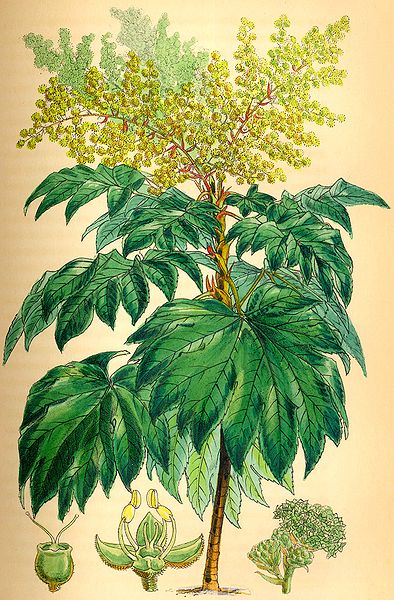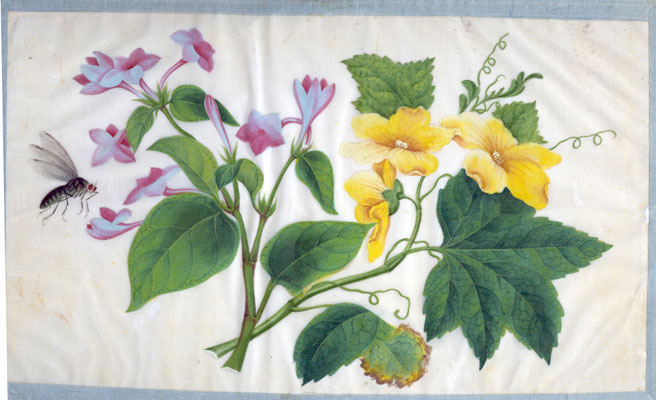esauboeck
Note on the Manufacture and Use of Pith Paper
by George A. Boeck, Dard Hunter Paper Museum 1988
The Dard Hunter Paper Museum has recently received some inquiries regarding the conservation practices for what is commonly called pith or rice paper. A search of the literature indicates that very little has been written on the topic. Fortunately, the museum had a sufficient number of undecorated sheets of this material to allocate some specimens for examination and experimentation. Stephanie Watkins, an intern working at the museum as part of her graduate program in art conservation at Buffalo State College, agreed to test the effects of standard conservation practices on a few of these sheets. Ken Grabowski of the Field Museum assisted us through his work on a bibliographic project tracing the misnomer "rice paper" in the botanical and popular literature.
 |
Neither rice nor, strictly speaking, paper, the sheets are actually shaved from the pith of the plant Tetrapanax papyrifera which is indigenous to Taiwan. Examples in museum collections date largely from the end of the nineteenth century when illustrations of Chinese daily life and flora and fauna became popular tourist items among the sailors and merchants on ships visiting Canton. |  |
As a consequence of the popularity of pith paper illustrations, one finds numerous descriptions of the method of manufacture (Swinhoe 1865: 52-53, Rice 1878: Ferris 1888: 297-298, Hosie 1890: 23-24, Williams 1899: 113-114, Matthews 1930: 89-90, Hooker 1953: 79-84, Bell 1985: 103-119 Koretsky 1988: n.p., Harvard on-line), that by Swinhoe in 1865 being particularly clear and concise. The common Chinese names for the plant are bok-shung and, more commonly, tung-tsao or tsuso (Matthews 1930: 89). Indigenous to the mountainous regions of northwestern and eastern Formosa, the plant resembles the castor bean or sycamore.
The plant will usually reach twelve to fifteen feet (3.6 to 4.5 m) in height by its fourth or fifth year. Only the pith of the younger plants, however, is lustrous and white. These the natives harvest every two or three years, usually in winter. New shoots grow from the root stock after the cutting much like bamboo. They then soak the stems in running water for several days and cut them into one to two foot (30.5 to 61 cm) lengths. The pith is removed by driving a dowel against the ground while the stem is aligned above. The pith becomes spotted or looses its luster unless the resulting segment of pith is dried immediately. This drying process may occur in hollowed bamboo to straighten longer sections or to adhere small sections to one another.
Pith paper manufacturers or their agents visit the aboriginal mountain villages near where the plants are collected or cultivated, offering Chinese trade goods for the bundled segments of pith (Matthews 1930: 90). Prior to the Second World War a number of small factories each producing ten to fifteen thousand pounds of paper per year were operating in the Shinshiku Province. Currently only a single factory seems to be operating (Koretsky 1988: n.p.).
Workers in the factories cut the pith into uniform pieces, usually about 3 3/8 inches (8.6 cm) long, although purchase of larger sheets can be arranged. From these segments, workers, usually women working at night in ill-lit rooms (Hosie 1890: 23, Koretsky 1988: n.p.), shave ribbons of pith paper. Their tools include a knife with a twelve inch (30.5 cm) long three inch (7.6 cm) wide blade having an extremely sharp edge and a one-half inch (1.3 cm) thick back. This tool is honed on a block of hardwood. The cutting surface is a smooth brick, stone, or tile measuring about fifteen inches (38 cm) long, six inches (15.2 cm) wide, and one inch (2.5 cm) thick. Horizontal brass strips along the length of this block act as a thickness gauge.
Proceeding quickly to insure uniform thickness (Hooker 1853: 80), the worker uses the left hand to roll the pith and the right hand to guide the knife. At the end of each pass, she returns the pith and knife to the far right of the block until the section of pith is reduced to about an inch (2.5 cm) in diameter. A ribbon of four to six feet (1.2 to 1.8 m) is obtained from each section of pith. These ribbons are stacked and pressed in lots of seven hundred fifty to one thousand. The workers trim these stacks into 3 1/4 inch (8.25 cm) to 3 1/2 inch (8.9 cm) squares, although one can arrange to buy larger squares for painting. Simple as this process sounds, considerable dexterity is required to produce the sheets. The workers are apprenticed for three years, during which time they receive room and board from 3 their masters (Swinhoe 1865: 53).
The sheets are sorted into three grades. The first grade is pure white, without perforations. This grade is for export, primarily to China or Japan for painting or making into artificial flowers. The second grade may contain minor perforations, and may be off-color or show some spotting. This grade is usually used locally for making artificial flowers. The lowest grade, between ten and fifteen percent of the pith (Matthews 1930: 90), consists of trimmings and core. This material is used for packaging, absorbent dressings, folk medicines, and small buoys.
The paintings one finds on these papers range from 3 1/4 inch (8.25 cm) squares to four by six (10.2 by 15.2 cm) or even ten by fifteen inch sheets. (25.4 by 38.1 cm). They are prepared in an Oriental style of a figure without background. Museum collections most frequently contain images from natural history and depictions of daily life, especially Chinese professions and trades. To protect the extremely brittle edges, the sheets are often trimmed with ribbon and may be backed with paper. These paintings were made in workshops and sold in sets (Cobb 1956: 246-7). The only mention of an artist responsible for the paintings comes in 1849 from La Volee who identified Lam Qua's Cantonese workshop and studio as a source for paintings on pith and paper. Accounts by La Volee and other travelers make it quite clear, however, that pith paper watercolors were items of manufacture rather than artistic ventures (Crossman 1972: 117). Since the turn of the century, these workshops have produced Western-style embossed Christmas cards as well. Shops making artificial flowers to adorn women's hair and for export to the west, in fact, use the bulk of the pith produced (Flowers 1911: 23). Most of these flowers were made in Canton, Hong Kong, and Japan. The method manufacture involves dyeing for color, cutting the sheets into petal shapes, dampening, and shaping the sheets with the aid of metal tools (Swinhoe 1865: 53). Roses and violets were particularly life-like in appearance and scented. A small amount of the pith paper was attached to bamboo on a rattan frame to make strong, light, water-proof hats, that is pith helmets (Pith 1879).
In addition to the pith growing either wild or under cultivation in Formosa, some plants are cultivated in southern China, India, and Ceylon. The plant as cultivated in India and Ceylon is called taccado and its pith is processed mainly in Malay and Indo-China. The most frequent products are artificial flowers, small figures and toys, festival decorations, and lens paper (Wealth 1976: 199-200). The Indian plant called a shola, actually a legume, is produced in Singapore as floats, buoys, and light sun hats much like Tetrapanax (World 1888: 297-298).
BIBLIOGRAPHY
Bell, Lilian A. Papyrus, Tapa, Amate, and Rice Paper: Papermaking in Africa, the Pacific, Latin America and Southeast Asia. McMinnville, Oregon: Liliaceae Press, 1985.
Cobb, Margaret E. "Rice-paper Paintings: 'Trivialities' of China Trade." Antiques, March 1956, p. 246-247.
Crossman, Carl L. The China Trade: Export Paintings, Furniture, Silver, and Other Objects. Princeton: Pyne Press, 1972.
Hahne, Bruno. "Observations on the Pith of Fatsia Papyrifera." South African Journal of Natural History, April 1928, p. 19-203.
"Flowers from Pith." Harper's Weekly, March 25, 1911, p. 23.
Chinese Botanical Paintings: Tetrapanax papyriferum (Hook.) Koch, Harvard University Herbaria, http://www.huh.harvard.edu/libraries/Tetrap_exhibit/ChineseBotanicals.html. Consulted 11-23-2010.
Hooker, William Jackson, ed. "The Rice-Paper Plant." Hooker's Journal of Botany and Kew Garden Miscellany, vol. 5, 1853, p. 79-84.
Ferris, George. The World of Wonders. New York: Appleton, 1886.
Hosie, Alexander. Three Years in Western China. London: George Philip and Son, 1890.
Koretsky, Elaine. "During a visit..." Correspondence, 1988.
Reed, Charles S. "The Pith-paper Industry of Japan." Commerce Reports: A Weekly Survey of Foreign Trade, July 14, 1930, p. 89-90.
"Rice Paper of China." Scientific American, November 23, 1878.
Swinhoe, Robert. "Rice-paper of Formosa." Pharmaceutical Journal and Transactions, 1865, p. 52-53.
Wells, William S. The Middle Kingdom: A Survey of the Geography, Government, 5 Literature, Social Life, Arts, and History of the Chinese Empire and its Inhabitants. New York: Charles Scribner's Sons, 1899.
Wealth of India: A Dictionary of Indian Raw Materials and Industrial Products. New Delhi: Publications and Information Directorate, 1976.
Illustrations from Harvard University Herberia:
http://www.huh.harvard.edu/libraries/Tetrap_exhibit/ChineseBotanicals.html